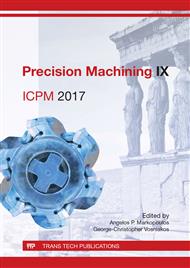[1]
P. Byrne, Turning milling and grinding processes, London, Arnold, (1996).
Google Scholar
[2]
I. D. Marinescu et all, Handbook of Machining with Grinding wheels, Boca Raton, CRC Press, 2007, 592 pp.
Google Scholar
[3]
J. Madl, Surface Properties in Precise and Hard Machining, Manufacturing Technology, Vol. 12, No. 13, 2012, pp.158-166.
DOI: 10.21062/ujep/x.2012/a/1213-2489/mt/12/2/158
Google Scholar
[4]
M. Novak, Surface quality of hardened steels after grinding, Manufacturing Technology, Vol. 11, No. 11, 2011, pp.55-59.
DOI: 10.21062/ujep/x.2011/a/1213-2489/mt/11/1/55
Google Scholar
[5]
M. Novak, R. Dolezal, G–Ratio in hardened steel grinding with different coolants, Manufacturing Technology, Vo. 12, No. 12, 2013, pp.192-197.
DOI: 10.21062/ujep/x.2012/a/1213-2489/mt/12/2/192
Google Scholar
[6]
M. Novak, Surfaces with high precision of roughness after grinding, Manufacturing Technology, Vol. 12, No. 13, 2012, pp.66-70.
DOI: 10.21062/ujep/x.2012/a/1213-2489/mt/12/1/66
Google Scholar
[7]
M. Novak, H. Kasuga, H. Ohmori, Differences at the Surface Roughness by the ELID and Grinding Technology, Manufacturing Technology, Vo. 13, No. 2, 2013, pp.210-215.
DOI: 10.21062/ujep/x.2013/a/1213-2489/mt/13/2/210
Google Scholar
[8]
J. Valicek, J. Rusnak, M. Müller, P. Hrabe, M. Kadnar, S. Hloch, M. Kusnerova, Geometricke aspekty drsnosti povrchu klasickych a netradicnich technologii, Jemna mechanika a optika, Vol. 53, No. 9, 2008, pp.249-253.
Google Scholar
[9]
M. Tavodova, The surface quality of materials after cutting by abrasive water jet evaluated by selected methods. Manufacturing technology, Vol. 13, No. 2, 2013, pp.236-241.
DOI: 10.21062/ujep/x.2013/a/1213-2489/mt/13/2/236
Google Scholar
[10]
K. Kouril, R. Cep, A. Janasek, A. Kriz, D. Stancekova, Surface integrity at reaming operation by MT3 head. Manufacturing Technology, Vol. 14, No. 2, pp.193-199, (2014).
DOI: 10.21062/ujep/x.2014/a/1213-2489/mt/14/2/193
Google Scholar
[11]
K. Dziedzic, J. Jozwik, M. Barszcz, The Assessment of Tribiological Properties and the Condition of the Surface of Tool Steel for Hot Work Subjected to the Process of Friction. Manufacturing Technology, Vol. 16, No. 1, 2014, pp.69-76.
DOI: 10.21062/ujep/x.2016/a/1213-2489/mt/16/1/69
Google Scholar
[12]
Z. Pitrmuc, J. Capek, K. Kolarik, L. Beranek, J. Urban, Tool Geometry Influence on Surface Integrity of Machined Austenite Stainless Steel. Manufacturing Technology, Vol. 16, No. 2, pp.425-431, (2016).
DOI: 10.21062/ujep/x.2016/a/1213-2489/mt/16/2/425
Google Scholar
[13]
S. Malotova, R. Cep, L. Cepova, J. Petru, D. Stancekova, L. Kyncl, M. Hatala, Roughness Evaluation of the Machined Surface at Interrupted Cutting Process, Manufacturing Technology, Vol. 16, No. 1, 2014, pp.168-173.
DOI: 10.21062/ujep/x.2016/a/1213-2489/mt/16/1/168
Google Scholar
[14]
Janos Kundrak, Csaba Felho 3D Roughness Parameters of Surfaces Face Milled by Special Tools Manufacturing Technology, Vol. 16, No. 3, 2016, pp.532-538.
DOI: 10.21062/ujep/x.2016/a/1213-2489/mt/16/3/532
Google Scholar
[15]
U. Prisco, A. Squillace, F. Scherillo, F. Coticelli, A. Astarita, Form and Dimensional Accuracy of Surfaces Generated by Longitudinal Turning, Manufacturing Technology, Vol. 16, No. 3, 2016, pp.595-600.
DOI: 10.21062/ujep/x.2016/a/1213-2489/mt/16/3/595
Google Scholar
[16]
T. Hanes, P. Hvizdos, M. Tavodova, D. Kalincova, J. Hricova, P. Beno. Non-destructive Magnetic Evaluation of Ground Surfaces Made of Bearing Steel of Variable Hardness Manufacturing Technology, Vol. 14, No. 3, 2014, pp.09-317.
DOI: 10.21062/ujep/x.2014/a/1213-2489/mt/14/3/297
Google Scholar
[17]
M. Tavodova The surface quality of materials after cutting by abrasive water jet evaluated by selected methods, Manufacturing Technology, Vol. 13, No. 2, 2014, pp.36-241.
DOI: 10.21062/ujep/x.2013/a/1213-2489/mt/13/2/236
Google Scholar
[18]
K. Osicka, Prumerna aritmeticka uchylka drsnosti povrchu - statisticke vyhodnoceni plochy Strojirenska technologie, Vol. 14, No. 1, 2009, pp.30-32.
Google Scholar


